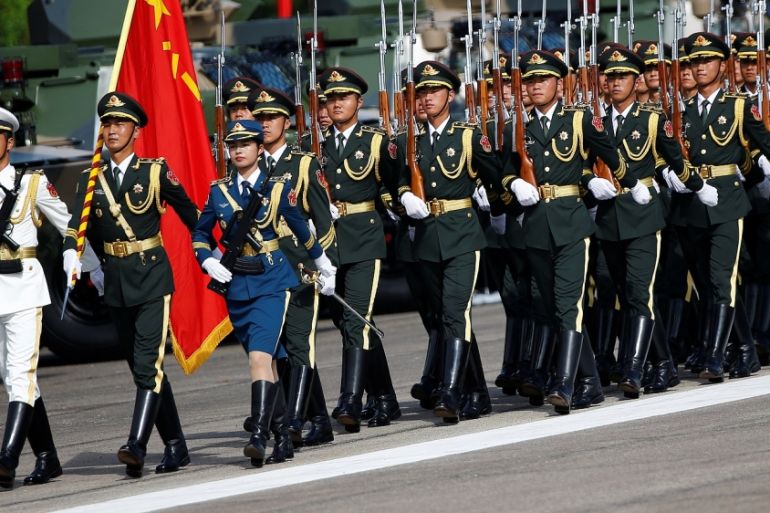China rotates new troops into Hong Kong amid crackdown fears
Beijing describes as ‘routine’ the movement of Chinese forces, estimated at between 8,000 and 10,000 soldiers.

China rotated thousands of new troops into its garrison in Hong Kong on Thursday days before protesters planned to hold a march calling for full democracy after three months of sometimes violent demonstrations.
China’s military will make even greater contributions to maintaining Hong Kong’s “prosperity and stability”, state news agency Xinhua cited the People’s Liberation Army (PLA) in the territory as saying.
Keep reading
list of 4 itemsHong Kong’s new security law comes into force amid human rights concerns
Hong Kong passes tough new national security law
What is Article 23, Hong Kong’s new draconian national security law?
It also described the troop movement in the early hours as “routine”, while Asian and Western diplomats watching the movements of the PLA in the former British colony had been expecting it.
Protesters in Hong Kong must respect the law and the military garrison there had the determination to defend the territory, defence ministry spokesman Ren Guoqiang told a news briefing.
Witnesses saw significantly more activity in and around the PLA’s Shek Kong military base in the rural New Territories than has been apparent in recent months.
“Before coming… we learned about the situation of Hong Kong,” PLA officer Lieutenant-Colonel Yang Zheng said in a PR video. “We’ve strengthened our training … to make sure we can fulfill our defence duties.”
Regardless of the movement being called routine, the timing was likely to hit nerves in the Special Administrative Region of Hong Kong, which returned to Chinese control in 1997 under a “one state, two systems” agreement.
In recent weeks, alarms were raised in Hong Kong after the massing of Chinese forces was revealed across the border in the mainland city of Shenzhen.
China has warned it will not “sit by and watch” as unrest continued in the semi-autonomous city.
Mass protest planned
The rotation came less than 24 hours after police denied permission for a new mass rally planned for Saturday that was expected to draw hundreds of thousands of people to the streets – the 13th consecutive week of protests.
Police have previously denied permission for rallies to take place, but the orders have largely been ignored.
The Civil Human Rights Front, the organiser of previous demonstrations, plans a rally from Hong Kong’s central business district to Beijing’s main representative Liaison Office in the city on Saturday.
The group’s leader, Jimmy Sham, was attacked by two men armed with a knife and a baseball bat on Thursday, it said on its Facebook page. He was not hurt but a friend who stepped in to protect him suffered injuries to his left arm and was taken to hospital.
In a letter to the rally organisers, police said they feared some participants would commit “violent and destructive acts”.
Protesters have so far carried out “arson and large scale road blockades” and “used petrol bombs, steel balls, bricks, long spears, metal poles, as well as various self-made weapons to destroy public property”, the letter said.
Last Sunday police deployed water cannon for the first time and one officer fired a live-round warning shot from his sidearm to fend off hardcore protesters after a sanctioned rally erupted into some of the worst violence of the past three months.
‘No change’
|
|
In 2018, the Chinese army had executed a similar troop rotation, saying in a statement at the time it “maintained with no change” the number of troops and amount of equipment stationed in Hong Kong.
However, that reassurance was not included in Thursday’s announcement.
Observers estimate the Hong Kong garrison numbers between 8,000 and 10,000 troops, split between bases in southern China and a network of former British army barracks in Hong Kong.
Hong Kong has been engulfed in angry and violent demonstrations against the government sparked by a now-suspended extradition bill and concerns Beijing was trying to bring the territory under greater mainland control.
The protests are the greatest political challenge to Hong Kong’s government since the territory returned to Chinese rule in 1997, and one of the biggest popular challenges to President Xi Jinping since he came to power in 2012.
Foreign hand?
China has denounced the demonstrations and accused the United States and the United Kingdom of interfering in its affairs in Hong Kong, warning that forceful intervention was possible.
On Tuesday, Beijing again warned against foreign interference in Hong Kong after the leaders participating in the G7 summit issued a statement calling for calm and supporting Hong Kong’s autonomy.
Hong Kong leader Carrie Lam has not ruled out the possibility of her administration invoking emergency powers to quell the protests.
She said in a news briefing on Tuesday the violence was becoming more serious, but she was confident the Hong Kong government could handle the crisis itself.